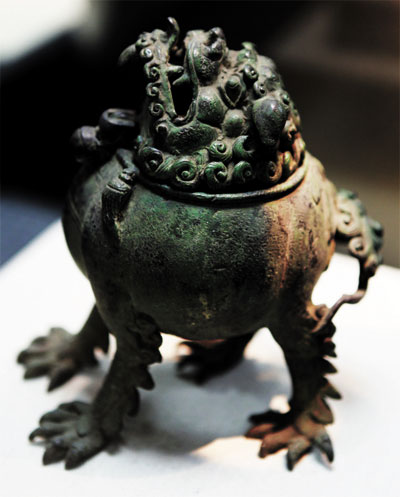|

Cao Zhen
caozhen0806@126.com
AN exhibition of ancient relics from southwestern Sichuan Province is being held at the Shenzhen Museum’s Civic Center outlet. Featuring a spectacular selection of articles for daily use, the exhibition explores the fascinating culture of the Song Dynasty (960-1279).
The 201 works in the exhibition include silver teapots and vases, bronze incense burners, exquisite ink stones, fantastic gold vessels and elegant porcelains that are among the most unusual and striking objects created during the Song Dynasty.
The exhibits, unearthed in the 1990s, are on loan from three museums in Sichuan Province. “According to historians, the relics were buried by locals or traders when Mongolian troops attacked the Song Dynasty from 1235 to 1279. The relics were found at 40 different locations around Sichuan Province, the famous locations being Suining, Deyang, Jianyang and Shifang,” said Xie Zhicheng, curator of the Sichuan Museum. “Most of the treasures were well preserved in tightly sealed cases before being placed underground while some large objects had to be buried directly in the earth. These relics showcase the Song Dynasty’s highly developed civilization, with sophisticated bronze and porcelain industries and an extraordinary art tradition,” Xie added.
Among the highlights of the exhibition are Qingbai ware, which were made in Jingdezhen in Jiangxi Province. Qingbai in Chinese literally means “clear blue-white.” Qingbai glaze is a porcelain glaze that when applied over a white porcelain body, produces a greenish-blue color. Some exhibits have incised or molded decorations, possibly representing clouds or clouds reflected in water.
Qingbai initially appeared in the Northern Song Period (960-1127) and quickly became a highly sought-after item. It became even more popular during the Southern Song Period (1127-1279). Kilns used to make Qingbai ware have been unearthed in many of China’s provinces, suggesting great popularity and widespread efforts to duplicate Qingbai throughout the realm.
At the exhibition, visitors can also admire Longquan celadon, a family of transparent glazes that were produced in Longquan kilns in southeastern Zhejiang Province. Longquan celadon displays the greatest variety of shape and glaze color, including white, gray, blue and yellow.
The Longquan celadon production area was one of the largest historical ceramic centers in the Song Dynasty, and celadon was well-known internationally. Large quantities of Longquan celadon were exported throughout East Asia, Southeast Asia and the Middle East in the 13th-15th centuries.
Guo Xuelei, vice curator of the Shenzhen Museum, noted that bronze wares at the exhibition should also not be missed, since bronze wares represent an unprecedented sculptural tradition of great artistic strength that flourished in the Song Dynasty.
He said scholar-officials during the Song Dynasty became highly interested in retrieving ancient relics from archaeological sites in order to revive the use of ancient vessels in state ritual ceremonies. Large quantities of bronze vessels were re-created during the Song Dynasty.
Dates: Until May 3
Hours: 10 a.m.-6 p.m. Closed Mondays
Venue: Shenzhen Museum, Block A, Civic Center, Futian District (福田区市民中心A区深圳博物馆新馆)
Metro: Shekou or Longhua Line, Civic Center Station (市民中心站), Exit B
|

